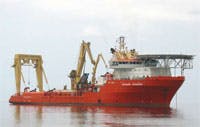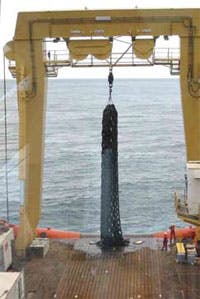Fluid Power Negates the Sea’s Pitch-and-Roll
The old adage “time is money” is often overused, but it is intensely relevant in the offshore, maritime, and dredging sectors. When surging seas force cancellation of work, each hour of inactivity equals no production and no profit. However, an innovative new range of Active Heave Compensators (AHCs) gives designers the technology to optimize underwater operations, even in heavy weather conditions.
In the past, excessively high waves often brought operations to a halt, leading to weeks and even months when lowering and lifting materials and equipment to and from the seafloor could not be done. Advanced measurement and control technology combined with modern hydraulics and pneumatics technology have added months of extra work time for offshore industries on a global basis.
Battling the waves
Deep undersea work is most common in the oil and gas industry. I t typically includes work such as oil and natural gas pipeline construction and repair, placement of oil and gas wellheads on the seafloor, and constant maintenance and repair activities. Other potential uses of AHCs include underwater mining, salvage, geotechnical surveys, and dredging — essentially any activity requiring controlling movement of loads to and from the sea floor. The loads carried on the steel cables can be up to 700 tons (for steel and concrete pipeline support structures) and be lowered to depths reaching 300 m.
These applications frequently involve expensive, heavy components and require a high level of control — particularly when being placed with or linked to other components on the seabed. As pipelines and other components are lowered in heavy seas, the greatest danger arises if the construction moves up and down and act as a destructive hIn addition to the dangers posed by wave motion, work is being conducted at increasing depth, raising the risk that the long cables, set in motion by the movement of the ship on the ocean surface, can act as oscillating springs. The deeper the depth, the longer the cable, which can magnify the destructive forces if not properly controlled. If something goes wrong, it may not only lead to damage to the construction, but may also have significant environmental impact caused by damaged oil or gas pipes on the seabed. AHC helps to prevent this type of disaster.
Finding a solution
Netherlands-based Gusto BV developed the first generation of AHCs, along with Bosch Rexroth Corp. These successful models were built around an intelligent, rapidly controlled dualfunction hydraulic cylinder platform. “It dramatically improves a ship owner’s operating time and earnings potential,” emphasizes Arnold Krielen, in the Offshore Technology group at Rexroth. “Better compensation of the heaving of a working vessel means that work can continue for longer.”
The AHC system makes the raising, lowering, and handling of loads on floating vessels much safer and easier. The wire carrying the load is routed from the towing winch through the AHC system to actively compensate — or in effect cancel out — the ship’s movements in the pitch and swell of the open sea.
The AHC System combines hydraulic, pneumatic, and electric power and control component, integrated into the following units:
• Heave Compensator Unit (HCU), containing the hydraulic cylinder assembly, along with special front and aft wire guides called sheaves, and located in a dedicated, containerized housing that can be easily positioned on aft decks, • Air Vessel Unit (AVU), a completely outfitted air pressure vessel unit, optional in a housing, • E-H-P Power Pack is the containerized electric, hydraulic, and pneumatic power generation and control, and • Operator Control Panel (OCP) contains the controls and condition readouts to operate and monitor the AHC system.
All of the major components are housed in hardened, weatherproof containers for efficient placement and integration with existing aft deck winch systems. Secure hatch covers isolate equipment from air and water penetration during non-operating conditions. An effective AHC increases the safety of the ship, the cargo, and the crew — and significantly reduces the risk of damage to components intended for placement on the seabed.
Compensator operation
To operate, a load (such as an undersea pipe) is suspended by steel wire rope. The wire rope unthreads from the ship winch, and then runs through two sheaves attached to the HCU rod, which is attached to the hydraulic cylinder assembly. The wire and load are then “reeved” over an overboard sheave unit into the water.
To control the operation, the AHC cylinder contains both an active and passive part. A passive heave compensation compartment suspends the static load — the pipes being lowered. This passive system is pneumatically powered and acts as a spring with a low spring coefficient. This essentially “zeroes out” the load at the end of the wire rope.
A Motion Reference Unit (MRU) measures the movements of the vessel in pitch, roll, and heave directions. The control system uses the output of the MRU to calculate the required ACH cylinder movement and controls the cylinder to follow the desired movement as accurately as possible. The sheave assembly attached to the AHC cylinder moves back and forth, counteracting the movements the ship is experiencing. This results in a nearly steady position of the lift point (at the location of the overboard sheave) and thus a nearly steady load with respect to the fixed world.
Accumulators help with secondary control technology
AHC enables the movements of the cable taking the load to the seabed to be independent of wave motion and/ or oscillating movements in the cable. Rexroth continues to enhance AHC design and component integration, says manager, design and development, Maarten Kuijpers. “We have not only the proven linear system but have also developed a new range of rotating AHCs that also uses the energyefficient secondary control.”
In this configuration, the primary load (the element being lowered or raised) and the additional wave motion and oscillations are managed and compensated by means of a secondary control system. During the operation, the cable load and the movements of the ship are constantly monitored with accurate, fast sensors. The signals produced by these sensors are then translated by a specially designed control system into dynamic control of the secondary motor, actively controlling the load in real time. There are various control software packages for different load, range, and pressure settings.
This system design offers an additional advantage: the use of an integrated energy recovery system based on hydraulic accumulators. “The possibility provided by hydraulics is that you can convert motion into force and then store this force in hydraulic accumulators,” Kuijpers said. The fact that ‘brake energy’ is stored in the hydraulic battery means the AHC systems can operate with far less installed power capacity. For example, 600 kW of hydraulic power drives a system with a total capacity of 3.6 MW. This saves you a factor of six on installed capacity."
New active winch system
“We keep listening carefully to the market and continuing to develop improvements for the system,” says Ad J.G. de Brouwer, with the Systems and Engineering business group of Bosch. “On the one hand, ship operators would like an AHC, but on the other hand, they do not want extra equipment on deck. So compact construction is important.”
This is why the passive (pneumatic) and active (hydraulic) cylinders in the linear AHC are integrated, or “piggybacked” into a single multifunctional cylinder. It means that the system requires less space on deck, leaving more space for the storage of equipment to be installed on the seabed. According to de Brouwer, another feature of the linear AHC is that the system is relatively easy to install and remove. The containerized equipment can be moved quite simply when not needed, or if it is to be mounted on a different ship.
The linear AHC is ideal for the handling of large loads up to 1000 tons. However, the linear AHC is a little on the ‘heavy side’ for lighter applications handling loads from 20-100 tons. One solution is an AHC system that is built directly onto the winch and therefore requires no extra equipment on deck. This system can be installed during ship construction and offers a cost effective alternative for installing active heave compensation in the case of overhauls or retrofits of the winch system on existing vessels.
In the rotating AHC system, the winches are fitted with a number of adjustable hydraulic axial plunger motors. The size and quantity are determined by the required winching capacity. Speed and torque of the motors can be manipulated with the adjustable wire rope laying plate, which varies the laying volume. The motors are also fitted with 4-quadrant control (left, right, harder, softer), to respond to pitch, yaw, and roll of the ocean surface. The rotating AHC system also uses the hydraulic energy recovery and storage system. A revolving cable drum represents a significant quantity of kinetic energy and when the cable is slowing (decelerating) the motors convert this energy into hydraulic pressure and store it in a hydraulic accumulator.
In comparison with the linear system, this rotating AHC system requires less complex pressure regulation around the hydraulic accumulator. This system is also more energy-efficient; the kinetic energy of the cable drum can be recovered, which is not possible with the linear system. The rotating AHC system is also easier to operate and requires less manpower to use: it is integrated into the winch controls and functions fully automatically when the desired ‘mode’ has been activated.
For more information, visit www.gustomsc.com or www.boschrexroth-us.com.
About the Author

Leaders relevant to this article:



